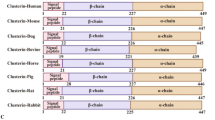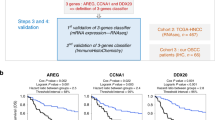Abstract
The CCN family of proteins consists of six members with conserved structural features. These proteins play several roles in the physiology and pathology of cells. Among the pathological roles of the CCN family, one of the most important and controversial ones is their role in the expansion and metastasis of cancer. Up to now a number of reports have described the possible role of each CCN family member independently. In this study, we comprehensively analyzed the roles of all six CCN family members in cell growth, migration and invasion of breast cancer cells in vitro and in vivo. As a result, we found the CCN2/CCN3 ratio to be a parameter that is associated with the metastatic phenotype of breast cancer cells that are highly metastatic to the bone. The same analysis with cell lines from oral squamous carcinomas that are not metastatic to the bone further supported our notion. These results suggest the functional significance of the interplay between CCN family members in regulating the phenotype of cancer cells.





Similar content being viewed by others
References
Babic AM, Kireeva ML, Kolesnikova TV, Lau LF (1998) CYR61, a product of a growth factor-inducible immediate early gene, promotes angiogenesis and tumor growth. Proc Natl Acad Sci USA 95:6355–6360
Brigstock DR (2003) The CCN family: a new stimulus package. J Endocrinol 178:169–175
Chen CC, Lau LF (2009) Functions and mechanisms of action of CCN matricellular proteins. Int J Biochem Cell Biol 41:771–783
Espinoza I, Liu H, Busby R, Lupu R (2011). CCN1 a candidate target for zoledronic acid treatment in breast cancer. Mol Cancer Ther in press
Fritah A, Saucier C, De Wever O, Bracke M, Bièche I, Lidereau R, Gespach C, Drouot S, Redeuilh G (2008) Role of WISP-2/CCN5 in the maintenance of a differentiated and noninvasive phenotype in human breast cancer cells. Mol Cell Biol 28:1114–1123
Guise TA, Mundy GR (1998) Cancer and bone. Endocr Rev 19:18–54
Jiang WG, Watkins G, Fodstad O, Douglas-Jones A, Mokbel K, Mansel RE (2004) Differential expression of the CCN family members Cyr61, CTGF and Nov in human breast cancer. Endcr Relat Cancer 11:781–791
Kang Y, Siegel P, Shu W, Drobnjak M, Kakonen SM, Cordón-Cardo C, Guise TA, Massagué J (2003) A multigenic program mediating breast cancer metastasis to bone. Cancer Cell 5:537–549
Kawaki H, Kubota S, Minato M, Moritani NH, Hattori T, Hanagata H, Kubota M, Miyauchi A, Nakanishi T, Takigawa M (2003) Novel enzyme-linked immunosorbent assay systems for the quantitative analysis of connective tissue growth factor (CTGF/Hcs24/CCN2): detection of HTLV-1 tax-induced CTGF from a human carcinoma cell line. DNA Cell Biol 22:641–648
Kawaki H, Kubota S, Suzuki A, Yamada T, Matsumura T, Mandai T, Yao M, Maeda T, Lyons KM, Takigawa M (2008a) Functional requirement of CCN2 for intramembranous bone formation in embryonic mice. Biochem Biophys Res Commun 366:450–456
Kawaki H, Kubota S, Suzuki A, Lazar N, Yamada T, Matsumura T, Ohgawara T, Maeda T, Perbal B, Lyons KM, Takigawa M (2008b) Cooperative regulation of chondrocyte differentiation by CCN2 and CCN3 shown by a comprehensive analysis of the CCN family proteins in cartilage. J Bone Miner Res 23:1751–1764
Kubota S, Takigawa M (2007) Role of CCN2/CTGF/Hcs24 in bone growth. Int Rev Cytol 257:1–41
Kubota S, Takigawa M (2011). The role of CCN2 in cartilage and bone development. J Cell Commun Signal in press
Kubota S, Kawata K, Yanagita T, Doi H, Kitoh T, Takigawa M (2004) Abundant retention and release of connective tissue growth factor (CTGF/CCN2) by platelets. J Biochem 136:279–282
Leask A (2011). Possible strategies for anti-fibrotic drug intervention in scleroderma. J Cell Commun Signal in press
Leask A, Abraham DJ (2006) All in the CCN family: essential matricellular signaling modulators emerge from the bunker. J Cell Sci 119:4803–4810
Lin CG, Leu SJ, Chen N, Tebeau CM, Lin SX, Yeung CY, Lau LF (2003) CCN3 (NOV) is a novel angiogenic regulator of the CCN protein family. J Biol Chem 278:24200–24208
Menendez JA, Vellon L, Mehmi I, Teng PK, Griggs DW, Lupu R (2005) A novel CYR61-triggered ‘CYR61-alphavbeta3 integrin loop’ regulates breast cancer cell survival and chemosensitivity through activation of ERK1/ERK2 MAPK signaling pathway. Oncogene 2005(24):761–779
Nakanishi T, Nishida T, Shimo T, Kobayashi K, Kubo T, Tamatani T, Tezuka K, Takigawa M (2000) Effect of CTGF/Hcs24, a product of a hypertrophic chondrocyte-specific gene, on the proliferation and differentiation of chondrocytes in culture. Endocrinology 141:264–273
Perbal B (2004) CCN proteins: multifunctional signalling regulators. Lancet 363:62–64
Perbal B, Takigawa M (2005) CCN proteins: a new family of cell growth and differentiation regulators. Imperial College Press, London
Sasaki A, Boyce BF, Story B, Wright KR, Chapman M, Boyce R, Mundy GR, Yoneda T (1995) Bisphosphonate risedronate reduces metastatic human breast cancer burden in bone in nude mice. Cancer Res 55:3551–3557
Shimo T, Nakanishi T, Nishida T, Asano M, Kanyama M, Kuboki T, Tamatani T, Tezuka K, Takemura M, Matsumura T, Takigawa M (1999) Connective tissue growth factor induces the proliferation, migration, and tube formation of vascular endothelial cells in vitro, and angiogenesis in vivo. J Biochem (Tokyo) 126:137–145
Shimo T, Kubota S, Yoshioka N, Ibaragi S, Isowa S, Eguchi T, Sasaki A, Takigawa M (2006) Pathogenic role of connective tissue growth factor (CTGF/CCN2) in osteolytic metastasis of breast cancer. J Bone Miner Res 21:1045–1059
Tsai MS, Bogart DF, Castañeda JM, Li P, Lupu R (2002) Cyr61 promotes breast tumorigenesis and cancer progression. Oncogene 21:817881–817885
Xie D, Nakachi K, Wang H, Elashoff R, Koeffler HP (2001) Elevated levels of connective tissue growth factor, WISP-1, and CYR61 in primary breast cancers associated with more advanced features. Cancer Res 61:8917–8923
Yanagita T, Kubota S, Kawaki H, Kawata K, Kondo S, Takano-Yamamoto T, Tanaka S, Takigawa M (2007) Expression and physiological role of CCN4/Wnt-induced secreted protein 1 mRNA splicing variants in chondrocytes. FEBS J 274:1655–1665
Yoneda T (1998) Cellular and molecular mechanisms of breast and prostate cancer metastasis to bone. Eur J Cancer 34:240–245
Acknowledgments
This work was supported by the programs Grants-in-Aid for Scientific Research (S)[to M.T.] and (C) [to S.K.] from Japan Society for the Promotion of Science, and by a grant from the program Grants-in-Aid for Exploratory Research from the Ministry of Education, Culture, Sports, Science, and Technology of Japan [to M.T.]. Work performed in B. Perbal’s laboratory was funded by French Ministry of Education: EA1556; and by European PROTHETS (Prognosis and Therapeutic Targets of Ewing Family of Tumors, FP6 Contract 503036). We thank Dr. Takanori Eguchi for useful discussions, and Ms. Yoko Tada for valuable secretarial assistance.
Author information
Authors and Affiliations
Corresponding authors
Rights and permissions
About this article
Cite this article
Ohgawara, T., Kubota, S., Kawaki, H. et al. Association of the metastatic phenotype with CCN family members among breast and oral cancer cells. J. Cell Commun. Signal. 5, 291–299 (2011). https://doi.org/10.1007/s12079-011-0133-3
Received:
Accepted:
Published:
Issue Date:
DOI: https://doi.org/10.1007/s12079-011-0133-3




